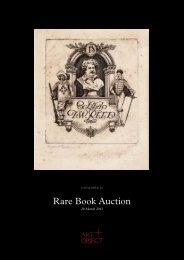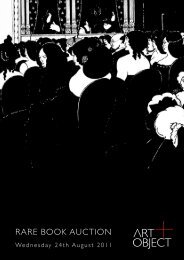You also want an ePaper? Increase the reach of your titles
YUMPU automatically turns print PDFs into web optimized ePapers that Google loves.
74<br />
Don Binney<br />
The Madness of the Pipiwharauroa<br />
oil on board<br />
signed and dated ’63<br />
760 x 880mm<br />
Exhibited:<br />
‘Third Biennale of Paris’, Paris, 1963<br />
(original exhibition label affixed verso).<br />
‘Don Binney: An Exhibition of Paintings<br />
and Drawings’, Ikon Gallery, Auckland,<br />
October 15 – October 27, 1963.<br />
Illustrated:<br />
Damian Skinner, Don Binney: Nga Manu/<br />
Nga Motu – Birds Islands (Auckland<br />
University Press, 2003), pl. 3.<br />
Provenance:<br />
Purchased by the current owner’s parents<br />
directly from the artist.<br />
Private collection, Auckland.<br />
$75 000 – $100 000<br />
Don Binney’s emblematic bird images have their genesis in a sequence of<br />
pipiwharauroa paintings made in 1962 and 1963. It would be difficult to point to<br />
a more crucial work in the development of Binney’s oeuvre than The Madness<br />
of the Pipiwharauroa - here the bird motif suddenly comes into full focus,<br />
resolving itself into a sharp clarity of form and style which sets the pattern for<br />
much of his later painting.<br />
The inspiration for the pipiwharauroa image came from Binney’s backyard,<br />
which shared a fence with Queen Victoria School, the Maori girls’ boarding<br />
school in Parnell. One day Binney watched entranced as a pipiwharauroa<br />
or shining cuckoo, the beautiful annual migrant from Samoa, announced<br />
its advent in a burst of song from a karaka tree near the fence. He painted<br />
the bird in a work called Pipiwharauroa in Advent (1962), with a chorus of<br />
Maori girls singing in accompaniment beneath the tree. Staying with the bird<br />
theme, Binney produced more pipiwharauroa works, eliminating the girls<br />
and reducing the key elements of the image to a highly schematised set of<br />
shapes and colours, yet retaining the poetic associations of the pipiwharauroa<br />
which features in so many Maori songs and poems. In The Madness of the<br />
Pipiwharauroa the bird is a heraldic figure, with wings outstretched and beak<br />
open in full voice, appearing over a vista of sea, sky and coast. The manaialike<br />
treatment of the beak is a conscious evocation of Maori visual tradition<br />
– an ack<strong>now</strong>ledgement which becomes even more pronounced in later bird<br />
images. The work heralds Binney’s spectacular early maturity, just as the<br />
pipiwharauroa heralds the advent of spring. In distilling the image down to its<br />
essentials Binney gets closer to its symbolic potentials. The formally simplified,<br />
yet symbolically complex interrelationship of bird figure and landscape, the<br />
principal concern of the artist throughout his later career, is fully realised in<br />
The Madness of the Pipiwharauroa. The backdrop suggests Binney’s beloved<br />
Auckland west coast with its black sand and wide ocean views – perhaps in<br />
reference to the bird’s energetic annual migration from Central Polynesia. The<br />
drifting, settling nature of life on Pacific islands is marvellously suggested by<br />
the fecund drop of greenery, indicating forest vegetation, and the lozenge<br />
of rich orange, deriving from karaka berries. The ‘madness’ of the bird is<br />
enthusiastic, effusive, affirmative, bursting with life, delirious in pursuit of its<br />
mating rituals over thousands of miles of open ocean, ready to enrich these<br />
shores in spring and summer with its marvellous song. In perfect harmony<br />
with its heraldic form and themes of advent and arrival, The Madness of the<br />
Pipiwharauroa was a brilliant inclusion from New Zealand in the Third Biennale<br />
of Paris in 1963, and a signal piece in Binney’s first solo exhibition at the Ikon<br />
Gallery in Auckland in the same year.<br />
Oliver Stead<br />
52

















